- TOP
- > Products Search
- > Solar charge modules
Solar charge modules
Solar charge modules are the key to the sustainable future
The WSC series of solar charge modules can be used in systems for compact independent power supplies that use lithium-ion batteries. They are also compatible with lead batteries, and because our line-up can fit with capacities, you can choose to suit the application being used and the installation location.
These modules can also be used just with easy settings to fit with solar panels and batteries.
In particular, we are endorsed by customers who are looking for solar charge controllers for use with lithium-ion batteries. High charging efficiency due to MPPT control and low-noise performance that reduces the effect on wireless devices, etc. are some of the reasons for our popularity with customers. And that's not all. Another reason that customers make a point of choosing WSC is our service, which also includes solutions such as proposals relating to the surroundings of power supplies and to nearby devices, including batteries and solar panels.
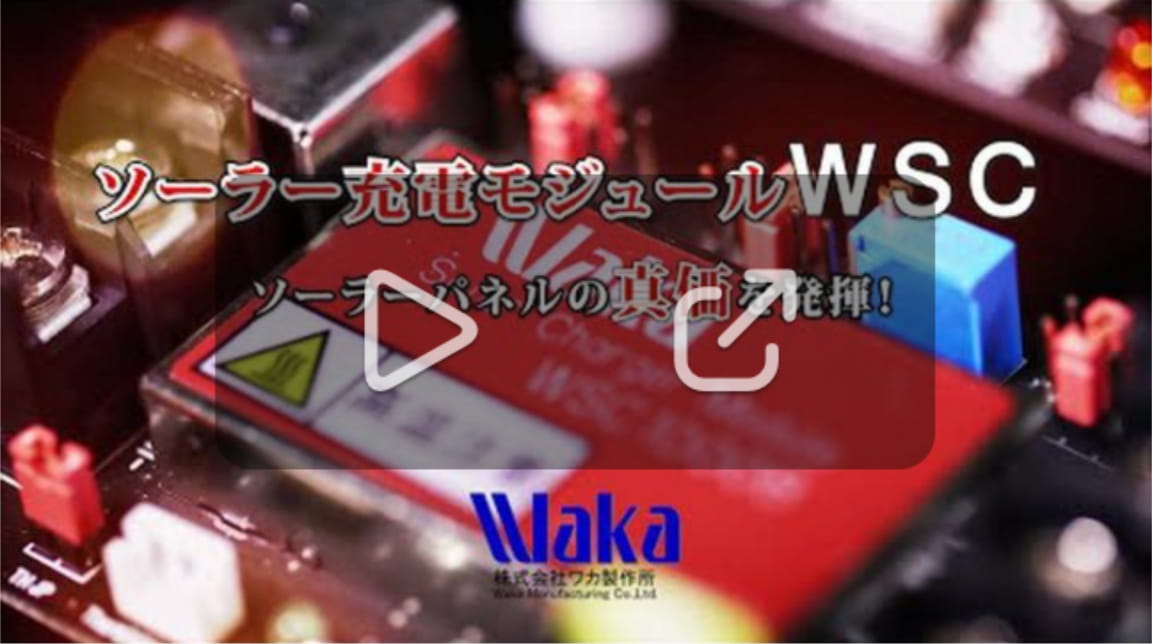

Solar charge modules


Solar charge modules are the key to the sustainable future
The WSC series of solar charge modules can be used in systems for compact independent power supplies that use lithium-ion batteries. They are also compatible with lead batteries, and because our line-up can fit with capacities, you can choose to suit the application being used and the installation location.
These modules can also be used just with easy settings to fit with solar panels and batteries.
In particular, we are endorsed by customers who are looking for solar charge controllers for use with lithium-ion batteries. High charging efficiency due to MPPT control and low-noise performance that reduces the effect on wireless devices, etc. are some of the reasons for our popularity with customers. And that's not all. Another reason that customers make a point of choosing WSC is our service, which also includes solutions such as proposals relating to the surroundings of power supplies and to nearby devices, including batteries and solar panels.
-
 Advantages of solar charge modules
Advantages of solar charge modules
The PWM method is used in cheaper systems and with it, voltage that is seen as surplus electric power goes to waste. MPPT differs from PWM, in that surplus voltage is converted to electric current for charging. As a result, charging efficiency increases by around 20% with MPPT.
1. Charging is possible in adverse conditions, such as when it is raining or cloudy, as is the installation of equipment in locations where daylight hours are short.
2. It is possible to realize more compact panels and batteries, thereby suiting the need for smaller, more lightweight equipment.
3. Customers can realize lower costs with our unique designs for MPPT, which until now has been expensive.
-
 Specifications
Specifications
WSC2001 WSC2001EX WSC5002 WSC5002EX WSC10008 Model 

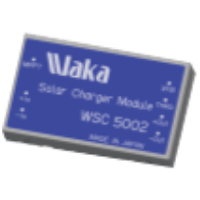

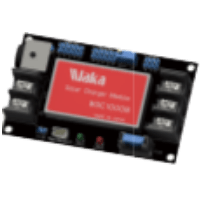
Charging control method MPPT Supported batteries Lithium-ion / Lead-acid MPPT voltage 8.1V(before shipment)~28V 17.2V(before shipment)~28V Output voltage 4.2V±5%(before shipment)~26V 12.3V±5%(before shipment)~26V Maximum output current 1A 2A 8A Usable temperature range -20℃~60℃ Recommended solor panel Maximum output 5W~30W 10W~100W 70W~150W Open-circuit voltage 10V~28V 18V~28V Dimensions 20×20×6.5mm 60×42×15.3mm 50×30×9mm 91×49×20.1mm 91×55×20.1mm Weight 6.6g 30g 30g 77g 80g Functions Overcharge protection ○ ○ ○ ○ ○ Overheating shutdown ○ ○ ○ ○ ○ Battery non-connection detection - ○ - ○ ○ Overcurrent protection - ○ - ○ ○ Overdischarge protection - ○ - ○ ○ External temperature sensor - ○ - ○ ○ Operation status LED display - ○ - ○ ○ AC adapter charging function - - - ○ ○ 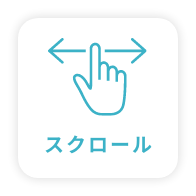
-
 Examples of solar panels and batteries
Examples of solar panels and batteries
Battery Solor panel WSC seriese Type Rated voltage Maximum output maximum power voltage(example) Open circuit voltage Lead
Pb6V 4W 9V MAX28V WSC5002/EX 12V 5W 17.5V 15W 17.4V 50W 18.63V 100W 17.5V WSC5002/EX or WSC10008 160W 18.1V WSC10008 Lithium iron phosphate
LiFePO46.4V 4W 9V MAX28V WSC5002/EX 12.8V 5W 17.5V 15W 17.4V 50W 18.63V 100W 17.5V WSC5002/EX or WSC10008 160W 18.1V WSC10008 Lithium cobalt oxide
LiCoO27.2V 4W 9V MAX28V WSC5002/EX 14.4V 5W 17.5V 15W 17.4V 50W 18.63V 100W 17.5V WSC5002/EX or WSC10008 160W 18.1V WSC10008 Lithium manganate
LiMn2O43.7V 2W 5.9V MAX28V WSC2001/EX 7.4V 4W 9V WSC5002/EX 14.8V 5W 17.5V 15W 17.4V 50W 18.63V 100W 17.5V WSC5002/EX or WSC10008 160W 18.1V WSC10008 
※The above is a part of the union example
-
 Requirements for solar charging
Requirements for solar charging

The three devices necessary for solar charging are a solar panel for converting the sun's energy into electricity, a battery for storing the electric power generated by the solar panel, and a charge controller for safely and efficiently charging that battery from the solar panel.
Furthermore, in order to safely use the electric power that is stored in the battery, it is necessary to have a charge and discharge controller to monitor the condition of the battery, and an inverter to convert the electricity that is necessary for the device being used.
Particularly with lithium-ion batteries, if their condition is not managed, not only will this lead to their considerable deterioration, it can also lead to serious accidents, such as the batteries emitting smoke or catching fire. As such, charge and discharge controllers play an important role.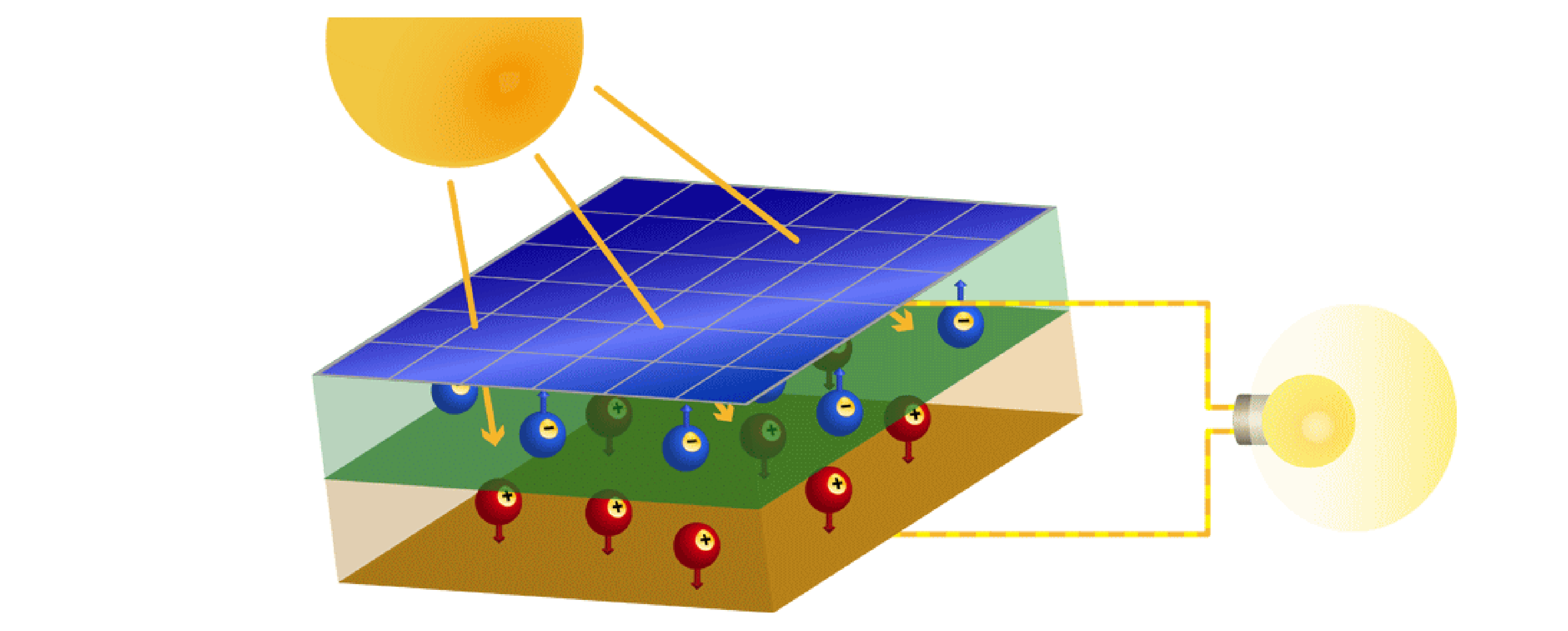
- How solar panels generate electricity
- When light is shined on two types of silicon semiconductors superimposed on each other, the electrons in the semiconductors begin to move. When a battery or light bulb is connected to these semiconductors, electricity flows.
- Types of solar panels in practice
-
Types of solar panels in practice
- Silicon-based
-
Silicon solar panels are currently the most widely used type of solar panel.
- Monocrystalline silicon type
- Silicon crystals are arranged in regular rows, so although conversion efficiency is high, it is expensive.
- Polycrystalline silicon type
- This type is made by melting and solidifying fragments of silicon crystals produced during the manufacture of monocrystalline silicon. Although the conversion efficiency is lower than that of monocrystalline silicon, the price is lower because it is easier to mass-produce and manufacturing costs can be reduced. It is currently the most widely used type of silicon.
- Amorphous silicon type
- Unlike monocrystalline and polycrystalline silicon, this panel uses amorphous silicon, which has an irregular crystal structure. It is less expensive than crystalline silicon. It is also lightweight, easy to process, and the voltage can be adjusted freely, but its conversion efficiency is only about half that of crystalline silicon.
- Other-coupling type
- This is a structure in which different solar cells are stacked on top of each other.
It has better conversion efficiency than the monocrystalline silicon type, but the manufacturing cost is higher.
- Compound type
-
- CIS/CIGS type
- The CIS type consists of copper, indium, and selenium as the three main materials. The CIGS type also uses gallium. Although they have a lower manufacturing cost than the silicon type, their conversion efficiency is lower than that of the silicon type.
- GaAs type
- GaAs type is made of gallium and arsenic, and its conversion efficiency is higher than that of monocrystalline silicon type, but it is currently used for only a few applications such as satellite applications due to its high cost.
- About battery, rechargeable battery, or storage battery
-
Battery, rechargeable battery, or storage battery Refers to rechargeable batteries that can be repeatedly charged and discharged. There are various types of batteries, ranging from small ones for electronic devices and mobile devices to large ones such as emergency power sources for facilities, etc., that make people's lives more convenient or protect human lives, depending on their applications and capacities.
- Main battery types and features
-
Main battery types and features Refers to rechargeable batteries that can be repeatedly charged and discharged. There are various types of batteries, ranging from small ones for electronic devices and mobile devices to large ones such as emergency power sources for facilities, that make people's lives more convenient or protect human lives, depending on their applications and capacities.
cell voltage operating temperature limits cycle life danger features Pb 2 0~40℃ 3150 safty / heavy LiCoO2 3.6~3.7 -20~60℃ 500~1000 fuming or ignition LiMn2O4 3.7~3.8 -20~50℃ 300~700 fuming LiFePO4 3.2~3.3 -20~60℃ 1000~2000 fuming Li(Ni-Mn-Co)O2 3.6~3.7 -20~60℃ 1000~2000 fuming or ignition LiNiO2 3.6 -20~60℃ 500 LiMn2O4 2.4 -20~60℃ 3000~7000 Does not ignite 
※There are differences in the nominal value depending on the manufacturer
-
 Solar charging method
Solar charging method
Electric power generated by solar panels varies depending on changes in daylight conditions, such as where the solar panels are installed and in what climate. But when a battery is charged with voltage that is unchanged and the maximum voltage that it can accept is exceeded, this can cause the battery to be damaged. And if the voltage is too low, electric power that has been accumulated can be lost due to electric current flowing from the battery to the solar panel side.
That is when a charge and discharge controller is needed. Charge and discharge controllers have two charging methods, each with its merits and demerits, so they should be selected to fit their purpose.- PWM (pulse width modulation) method
- Control with this method produces a fixed voltage and electric current.
The merits of this are that it can be introduced at a comparatively low price and enables charging at a constant efficiency, without the battery or load being affected.
A demerit is that charging is not possible at the greatest efficiency because it cannot be operated to suit daylight conditions, which are changing all the time.
- MPPT (maximum power point tracking) method
- Even in daylight conditions that are constantly changing, MPPT enables continuous control and is constantly monitoring to obtain the greatest possible electric power from the solar panels. Compared with PWM, one of its advantages is that it enables highly efficient charging.
Because of this high charging efficiency, users can expect to extend the operational period to when there is no direct sunlight, and the miniaturization of solar panels and batteries. A drawback is the higher cost of MPPT.
Our WSC series uses the MPPT method in a price range that is closer to PWM.
 Case Studies
Case Studies
-
LED sign lighting
Case Study
Marusan Kogei Co., Ltd.,
details here -
Portable power supply device for emergency use
Case Study
Orion Auto Craft
details here -
Water gauges
Case Study
Suwa University of Science's
"Tokyo Metropolitan University Liason Suwarika Brand Creation Project,"details here -
Power supply device for emergency use
Case Study
details here -
Solar LED street light
Case Study
Orion Auto Craft
details here -
Power supply device for automatic steering in a yacht
Case Study
details here
